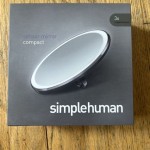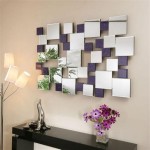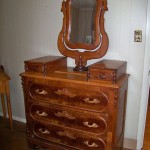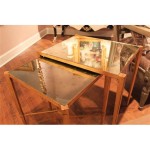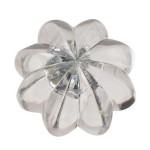What is a Mirror Image in Maths Class 9?
Mirror image, also known as reflection, is a fundamental concept in geometry taught in Class 9 mathematics. It involves transforming a shape or figure by flipping it over a line, which is referred to as the line of reflection or the mirror line. The resulting image is a mirror reflection of the original shape, meaning it is congruent (identical in size and shape) but oriented in the opposite direction.
The concept of mirror image is crucial for developing spatial reasoning and understanding symmetry. It provides a foundation for more advanced topics in geometry, such as transformations, coordinate geometry, and tessellations. In Class 9, students typically learn to identify mirror images, construct them using different techniques, and analyze the properties of shapes under reflection.
Understanding mirror images necessitates grasping the idea of congruence. Two figures are congruent if they have the same size and shape. Reflection is an isometric transformation, meaning it preserves distance. The distance between any two points in the original figure is the same as the distance between their corresponding points in the reflected image. However, the *orientation* of the figure changes. What was oriented clockwise in the original figure will be oriented counter-clockwise in its reflection, and vice-versa.
Several real-world applications illustrate the concept of mirror images. Mirrors themselves are the most obvious example. Reflections in still water also create mirror images. In art and design, symmetry and reflection are frequently used to create visually appealing patterns. Furthermore, the concept is relevant in fields like physics, particularly in optics and the study of light reflection.
Key Properties of Mirror Images
Several defining characteristics distinguish mirror images from the original figure. Being aware of these properties is essential for accurately constructing and analyzing reflections.
First and foremost, the distance from each point on the original figure to the line of reflection is identical to the distance from the corresponding point on the mirror image to the line of reflection. This distance is measured along a perpendicular line to the mirror line. Imagine drawing a line from a point on the original shape straight to the mirror. Continue that line on the other side of the mirror, the same distance, and you'll find the corresponding point on the reflected image.
Secondly, the line segment connecting a point on the original figure and its corresponding point on the mirror image is perpendicular to the line of reflection. This perpendicularity ensures that the reflection is accurate and that the image maintains the correct proportions. It's vital to ensure that, when constructing a mirror image, the lines used to measure distances to the mirror line create right angles.
Thirdly, mirror images maintain the size and shape of the original figure, meaning they are congruent. This congruence is a fundamental property of reflections. All angles and side lengths remain the same, even though the orientation is reversed. If the original figure is a square, its mirror image will also be a square of the same size. If the original figure is a triangle with specific angle measures, its mirror image will have corresponding angles of the identical measure.
Finally, the orientation of the figure is reversed. This is perhaps the most distinctive characteristic of a mirror image. Consider a letter 'R'. Its reflection will appear as a backwards 'R'. This reversal of orientation is what differentiates a reflection from other transformations such as translation (sliding) or rotation (turning).
Methods for Constructing Mirror Images
In Class 9, students learn different methods for constructing mirror images. These methods can be broadly classified into geometric construction and coordinate-based construction.
Geometric construction involves using a ruler and compass to accurately draw the mirror image. The process typically involves the following steps:
- Draw the line of reflection (the mirror line).
- For each vertex (corner) of the original figure, draw a perpendicular line from the vertex to the line of reflection.
- Measure the distance from the vertex to the line of reflection.
- Extend the perpendicular line on the opposite side of the line of reflection by the same measured distance. This marks the corresponding vertex of the mirror image.
- Repeat steps 2-4 for all vertices of the original figure.
- Connect the vertices of the mirror image in the same order as they are connected in the original figure.
This method relies on the properties of mirror images, particularly the perpendicularity and equal distance from the line of reflection. Precision is key to obtaining an accurate mirror image. Students should practice these steps carefully to ensure the final figure is indeed a mirror image and congruent to the original.
The coordinate-based construction is used when the figure is defined by its coordinates on a coordinate plane. The line of reflection is often one of the axes (x-axis or y-axis) or a line parallel to one of the axes. The reflection rules are as follows:
- Reflection across the x-axis: The x-coordinate remains the same, and the y-coordinate changes sign, i.e., (x, y) reflects to (x, -y).
- Reflection across the y-axis: The y-coordinate remains the same, and the x-coordinate changes sign, i.e., (x, y) reflects to (-x, y).
For example, if a point has coordinates (3, 2) and it is reflected across the x-axis, its new coordinates will be (3, -2). If it is reflected across the y-axis, its new coordinates will be (-3, 2). Once the coordinates of all the vertices of the figure are determined, they can be plotted on the coordinate plane and connected to form the mirror image.
When reflecting across other lines that are not the axes (e.g., y = x, y = -x), more complex transformations are involved, but the same principles of perpendicularity and equal distance apply. Students will often encounter these types of reflections in higher grades.
Applications and Significance in Geometry
The concept of mirror images is not merely an abstract geometrical idea but has significant applications within geometry and in broader mathematical and real-world contexts.
One crucial application lies in understanding symmetry. A figure is said to be symmetrical with respect to a line if it is its own mirror image across that line. This line is then referred to as the line of symmetry or the axis of symmetry. Recognizing and identifying lines of symmetry is a key skill in geometry, allowing for efficient analysis and classification of shapes.
For instance, an equilateral triangle has three lines of symmetry, each passing through a vertex and the midpoint of the opposite side. A square has four lines of symmetry: two passing through opposite vertices and two passing through the midpoints of opposite sides. A circle has an infinite number of lines of symmetry, all passing through its center.
Another important application is in the study of transformations. Reflection is one of the four fundamental isometric transformations (translation, rotation, reflection, and glide reflection) that preserve size and shape. Understanding reflections allows students to analyze and classify geometric figures based on their invariance under these transformations.
Furthermore, the concept of mirror images is used in tessellations or tilings. Tessellations are patterns formed by repeating geometric shapes to cover a plane without gaps or overlaps. Reflections can be used to generate tessellations by reflecting a basic shape across different lines. Many artistic and architectural designs employ tessellations derived from reflections and other geometric transformations.
Beyond pure geometry, the idea of mirror images finds applications in coordinate geometry, where transformations are represented algebraically using matrices. Reflection matrices are used to perform reflections on coordinate points. This is significant in computer graphics and animation, where geometric transformations are essential for creating realistic images and animations.
In summary, the concept of mirror images lays a strong foundation for understanding key geometrical principles such as congruence, symmetry, and transformations. These skills are valuable not only for further studies in mathematics but also for real-world applications in areas like design, architecture, and computer graphics.

Mirror Image Of A Cordinate In Cartesian Plane About X Axis And Y

Math Labs With Activity Obtain The Mirror Image Of A Given Geometrical Figure Plus Topper

Reflection Definition In The Coordinate Plane

Cbse Class 9 Maths Lab Manual Coordinate Geometry Sample Papers

Math Labs With Activity Obtain The Mirror Image Of A Given Geometrical Figure Plus Topper

Reflection Definition In The Coordinate Plane

Activity Coordinate Geometry Class 9 Maths Mirror Image Through X Axis Y And Origin

In The Figure Pq And Rs Are Two Mirrors Placed Parallel To Each Other An Incident Ray Ab Strikes Mirror At B Reflected Moves Along Path Bc

Reflections Mathematics Worksheet Mirror Line Activity

Mathslab Activity Mirror Image Of A Geometrical Figure With Respect To X Axis And Y Class Ix


